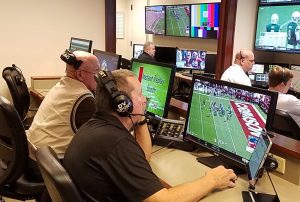The Audio Insider Q&A: Clear-Com’s Steve Sandford on IP evolution and 2018 expectations

The SEC Command Centre in Birmingham, Alabama, features an extensive DVSport/Clear-Com solution.
Every edition of the new monthly Audio Insider newsletter will include an exclusive Q&A with a leading broadcast audio vendor discussing current product developments and future industry trends. The first of these articles features Clear-Com product manager Steve Sandford looking back on what has been a remarkable year of development for IP-based solutions, and addressing what might be on the horizon for intercom as a whole in 2018…
How would you describe the last 12 months for Clear-Com in terms of its offer to, and presence in, sports broadcasting?
Clear-Com has seen a great deal of interest in the LQ ‘Intercom over IP’ interface devices this year, especially for Sports Broadcast applications. The portable LQ devices and the bigger brother LQ-R rack mount units provide remote intercom and GPIO connectivity over IP. This means that remote sports productions can home run intercom from the cameramen and local production team back to the central studios with ease over WAN or Internet connections. From LQ version 3 they can link back to the Eclipse HX matrix intercom using the LQ devices as end points into the production intercom. This enables intercom and commentary audio from remote locations back to a central hub. We see this used particularly in video refereeing (US football, baseball, ice hockey, Australian Rules Football and in sports broadcasting from horse racing, dog racing, tennis, and again football. Some content is sent with multi-language commentary.
To what extent has IP for intercom now been generally accepted by sports broadcasters and venues – or is there still more work to be done in this regard?

The LQ and bigger LQ-R devices provide remote intercom and GPIO connectivity over IP.
All new sports venues are being built with fully integrated IP systems and existing venues are regularly using IP over temporary installed fiber infrastructures to meet their broadcast production and internal venue management needs. As ever intercom is a key part of this, and as with any new technical change, there are early adopters who have been willing to take advantage of the benefits delivered by IP for enabling new workflows and projects.
Can you identify and outline one of your most important product launches of 2017?
Clear-Com had several new product launches within this year, but the LQ new software versions 3 and 4 have found the most favor with the Sports production community. LQ 3 provided connection from end-point LQs to matrix intercom over IP for both voice intercom and GPIOs and version 4 boosted capability with SIP telephony and Agent-IC mobile clients for smartphones and tablets.
In what primary ways are broadcasters’ expectations of intercom changing?
We see requests for interoperability between different vendors using IP to give a unified solution for remote video, audio, control and intercom. The expectation is that this increases ease and flexibility to configure the remote feeds through the facility with overarching diagnostics and routing visibility. The use of Audio over IP standards, such as Dante between devices or AES67 between sites is really helping to drive these changes.
Finally, as the new year looms into view, what can you tell us about Clear-Com’s plans for 2018? And do you have any predictions for the broadcast audio market as a whole?
In 2018 Clear-Com will continue to embrace standards based IP functionality, improving capacity, reach and interoperability. Sports venues and broadcasting is a major focus for Clear-Com and we are honored to be partnering with some of the best known global leagues and teams in many different sports and within many venues around the world.
In 2018 we expect the broadcast audio market in general to continue with its move to IP standardisation and push for harmonisation within the emerging media standards such as SMPTE 2110. We also consider that very low latency fiber based audio transport systems will thrive and sit side by side with IP based devices and the industry will continue to use these tools where each technology has its advantage.
